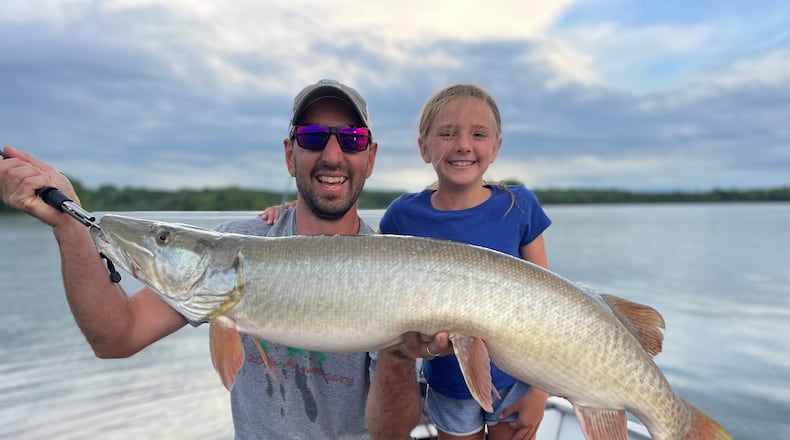The biggest, baddest member of the pike family (Esox, the old name for pike in Europe), what muskies most resemble is a freshwater barracuda. Often called the fish of 10,000 casts due to their relative scarcity and fickle feeding patterns, fall can be a great time to try your luck as they put on the feedbags for winter.
Native to Ohio
Muskies are native to Ohio in both the Lake Erie and Ohio River drainages. Young fish grow quickly to 30 inches and likely apex status. Their growth then slows, adding a couple of inches and pounds per year. But swimming around at the top of the food chain, they continue to get bigger.
The state record caught in the spring of 1972 at Lake Piedmont weighed 55 pounds and was 50.25 inches long. Numerous fish that measured longer have been caught, but none have exceeded the weight of that fish. Elsewhere, specifically north of Ohio and into Canada, fish in excess of 60 inches have been documented.
New hotspots
Relatively recently, two local reservoirs, Caesars Creek and C.J. Brown, were stocked with muskies by the Ohio Department of Natural Resources. Each lake was stocked with the a goal of one fish per surface acre of water. The Caesar Creek program started in 1998 and since 2000, has received around 2,804 advanced fingerlings annually. Beginning in 2018, C.J. Brown has seen 1964 fingerlings stocked each year.
According to Mike Porto, Fisheries Biologist at the ODNR, there were two things the department thought would make a stocking program successful on these lakes.
“Both reservoirs have healthy populations of gizzard shad,” he says. That provides ample food to survive. And second, “Most of the fish we stock stay in these reservoirs and do not escape downstream.”
That means anglers have realistic opportunities to catch these hungry fish as they feed on a buffet of gizzard shad.
Inevitably however, a small number do escape downstream and fish have been reported being caught in the Mad and Great Miami rivers. While they’re native to local streams, the fishery really depends on the stocking programs to sustain the population at a level that makes sense to target them.
The fish go through the spawning motions in the reservoirs but they haven’t spawned successfully.
What’s possible?
In 2017, Centerville resident Cole Menker caught a 50-inch muskellunge in Caesars Creek. Fish as big as 54 inches have been caught since, and there are surely bigger fish to be had as the lake has become a destination for muskie anglers all over.
C.J. Brown, while a much different lake than its neighbor to the south, is growing some big fish as well.
“I know there is a fish at least 45 inches there,” Porto says.
He was fishing on C.J. Brown with his family this summer, with no muskie luck.
He handed the rod to his 7-year-old daughter, who promptly hooked and landed a 45-inch fish on her second cast. That’s the biggest he’s seen there.
Are you ready?
If you decide to take a shot at muskies, be prepared. They’re big and they have teeth. Fluoro-carbon or steel leaders are recommended. They generally like big meals, so think big lures. This also means that you won’t catch many off-species small fish. It’s just you and the apex fish. Porto says that he’s had the best luck just keeping it simple with two classic muskie lures, “swim baits and bucktails.” You can’t go wrong those choices.
They have tough mouths and a strong grip, so bring a rod with some backbone to set the hook.
When you land one, a tool with a handle long enough to remove the hooks while keeping your hands away from a possibly thrashing fish will be greatly appreciated.
The axiom of 10,000 casts is just an average. It could be more, it could be less, like Porto’s daughter. That’s why dedicated muskie anglers across the state contribute to the state’s “muskie log.”
It’s a voluntary program where anglers report their trips and successes, helping the ODNR plan and document its achievements. If you catch one 40 inches or bigger, it will qualify you for Fish Ohio recognition.
If and when you do, be sure to thank your local fisheries biologist.
Devin Meister is a local outdoors and wildlife enthusiast and has a blog called “Average Guy Outdoors.” He is an Ohio University graduate. Reach him at meister.devin@gmail.com.
About the Author



